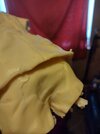Predatoj
Well-Known Member
So this is going out to folk with experience with resin casting in silicone molds. I'm casting resin into two part silicone molds but having casting errors which are expensive to discard and difficult to fix. The molds are too complicated and large to inject into a closed mold so I'm layering a 'beauty coat' into the mold using micro batches of resin, when it's thick enough I put the 2 halves together and through pre sculpted pour holes inject 60ml of resin with syringes and manually rotate the mold to join the two halves. When I de-mold I get horrible errors that are like doubling casting over casting and flaky delaminated layers. I hope that all made sense. I've attached photos. Question is, what is happening and how to avoid it? If it was just for me I'd just fill with model filler but these are for sale and can't sell them like that.
I'm using resin from a company called Tomps who are otherwise good.



I'm using resin from a company called Tomps who are otherwise good.

